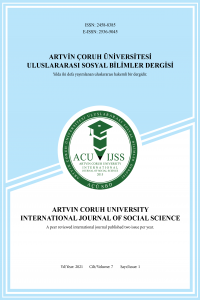İngilizce’yi Yabancı Dil Olarak Öğrenen Öğrencilerinin Dil Kurslarına Edebi Metinler Entegrasyonuna Yönelik Tutumlarının Ölçülmesi
Literatür, İngilizce’yi yabancı dil olarak öğrenimin sürecinde farklı işlemleri yerine getirmektedir. Bu nedenle, sıklıkla bir modül olarak öğrenilmektedir. Bundan başka, dil ile ilgili mödüllerde bütünleşik bir dilsel kaynağı temsil edebilir. Ancak, bazı öğrenciler tarafından takdir edilmeyebilir. Bu çalışmada öğrencilerinin dil kurslar içinde edebi metinler entegrasyonuna yönelik tutumlarını ve reaksiyonlarını incelenmiştir. Araştırma araçları olarak bir anket ve sınıf içi gözlemi kullanmıştır. İncelemenin örneklemini İngiliz dili bölümünden 30 öğrenci oluşturmuştur. Toplanan veriler nicel ve nitel olarak analiz edilmiştir. Elde edilen bulgular ışığında, öğrencilerin dil kurslarına edebi metinler entegrasyonuna yönelik olumlu tutumları bulunmuştur.
Anahtar Kelimeler:
Literatür, dil, reaksiyon, edebi metinler, entegrasyon
Gauging EFL Learners’ Responsiveness to the Incorporation of Literary Materials into Language Courses
Literature performs various functions in the process of learning English as a foreign language (EFL). Although it is studied as a subject-matter, it can represent a linguistic resource that is integrated into the language related modules. However, it may not be appreciated by all EFL students. Therefore, the present study attempts to investigate the learners’ attitudes and responsiveness to the integration of literary materials in language courses. It relied on the use of a questionnaire and classroom observation as instruments of gathering information from a sample of 30 EFL students. The collected data were analysed quantitatively and qualitatively. The main findings have revealed that most of the students respond positively to the literary discourse introduced in language tasks.
Keywords:
Literature, language, responsiveness, literary discourse, integration,
___
- Bancroft, J. (1999). Suggestopedia and Language Acquisition: Variations on a Theme. Amsterdam: Gordon and Breach Publishers.
- Bennet, L. (1966). Colonization in Reverse. Jamaica Labrish. Jamaica: Langster’s Book Stores. 179.
- Brumfit, C.J., and Carter, R.A. (1986). Literature and Language Teaching. Oxford: OUP.
- Burke, S.J, and Brumfit, C.J. (1986). Is Literature Language? Or Is Language Literature? In C.J. Brumfit and R.A. Carter (Eds.) Literature and Language Teaching. Oxford: OUP. 171-176.
- Celce Murcia, M. (2015). An Overview of Teaching Grammar in ELT In M.A Christison, D. Christian, P. Duff, and N. Spada (Eds) Teaching and Learning English Grammar: Research Findings and Future Directions. New York: Routledge. 03-18.
- Celce-Murcia, M and Olshtain, E. (2000). Discourse and Context in Language Teaching: A Guide for Language Teachers. Cambridge: CUP.
- Kramsch, C. (1993). Context and Culture in Language Teaching. Oxford: OUP.
- Larsen-Freeman, D. (2000). Techniques and Principles in Language Teaching. Oxford: OUP.
- Little, D., Devitt, S., and Singleton, D. (1994). The Communicative Approach and Authentic Texts. In A. Swarbrick (Ed.) Teaching Modern Languages. London: Routledge. 43-47.
- Richards, J.C., and Rodgers, T.S. (2014). Approaches and Methods in Language Teaching. Cambridge: CUP.
- Twain, M. (1876). The Adventures of Tom Sawyer. Toronto: Belford Brothers Publishers.
- Widdowson, P. (1999). Literature. London: Routledge.
- Wolfram, W. (2004). The Grammar of Urban African American Vernacular English. In B. Kortmann and E. Schneider (Eds.) A Handbook of Varieties of English. Berlin: Mouton De Gruyter. 111-132.
- ISSN: 2458-8385
- Yayın Aralığı: Yılda 2 Sayı
- Başlangıç: 2015
- Yayıncı: Artvin Çoruh Üniversitesi
Sayıdaki Diğer Makaleler
Artan Küresel Isınma ve Duyarsızlaşan Küresel Politikalar
Hasan ERYILMAZ, Kazım Onur DEMİRARSLAN
Üniversite Öğrencilerinin Mobil Oyun Profili ve Oynama Alışkanlıkları
Anadolu’da Orta ve Son Tunç Çağı Ölü Gömme Gelenekleri
Rekreatif Eğlencede Yeni Bir Tür: Kaçış ve Korku Evi Oyunları
Erdoğan EKİNCİ, Fatih Mehmet PARLAR, Burak GÜVENMAN, Oğuzhan YILDIZ, Ferizan PARLAR
